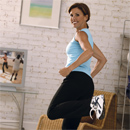

 Do you suffer from joint pain or joint stiffness? Have you been diagnosed with osteoporosis or osteoarthritis?
Do you suffer from joint pain or joint stiffness? Have you been diagnosed with osteoporosis or osteoarthritis?
According to Osteoporosis Canada, osteoporosis is a disease characterized by low bone mass and the deterioration of bone tissue, which leads to increased bone fragility and the risk of broken bones, especially bones of the hip, spine and wrist.
At least one in three women and one in five men will suffer from an osteoporotic fracture during their lifetime.
According to the Arthritis Society of Canada, osteoarthritis (OA) is the most common type of arthritis, affecting one in 10 Canadian adults.
It’s important to note that osteoporosis is not the same as osteoarthritis, although they have similar-sounding names.
Osteoporosis is a bone disease, whereas, osteoarthritis is a disease of the joints and surrounding tissue.
Cartilage, which covers and protects the ends of our bones, acts as a shock absorber and enables our joints to move smoothly. Osteoarthritis occurs when the cartilage begins to erode, resulting in joint pain, stiffness, swelling and bone-on-bone movement in the affected joint.
Sadly, there is no cure for osteoarthritis, but if you are diagnosed early and start the right treatment, you can still lead an active and productive life with the help of exercise, joint-protection techniques, rest, proper medication and, in some cases, surgery.
Joint pain and stiffness is a common characteristic of arthritis and can be extremely bothersome.
If you suffer from osteoarthritis, you may experience joint stiffness for up to 30 minutes after you get out of bed.
There are many other causes of joint pain and stiffness, such as overused joints, bone disease, cancer, influenza, tendonitis or joint trauma.
If you have arthritis, you need to exercise. Although it may seem counterintuitive, exercise will not increase your joint pain or worsen your joint stiffness. What it will do is reduce your joint pain and fatigue, while increasing your strength and flexibility. On the other hand, if you don’t exercise, your supporting muscles will weaken and cause even more stress to your joints.
To reduce your joint pain and stiffness, the Mayo Clinic suggests range-of-motion exercises, strengthening exercises, aerobic or endurance exercises and other activities such as yoga or tai chi.
According to SportsInjuryClinic.net, osteoarthritis of the knee is most common in people over 50, especially women. Knee osteoarthritis is also common in individuals who play intense physical sports, such as football. If you’ve had a previous knee injury, your risk of developing osteoarthritis in the future is quite high, as symptoms tend to develop slowly over a number of years.
If you have osteoarthritis of the knee, experts agree that exercise therapy can help you take control of your disease, and a home-based exercise DVD can be an effective way for you to receive exercise instruction.
Researchers have recently found a positive association between home-based DVD exercise programs and improvements in the quality of life, along with the reduction of joint pain and stiffness, in patients suffering from osteoarthritis of the knee.
The results of a study, published by Harukazu Tohyama, M.D., and Kazunori Yasuda, M.D., of Sapporo, Japan, were presented on February 8, 2012, at the Annual Meeting of the American Academy of Orthopaedic Surgeons (AAOS).
Researchers studied 107 individuals over the age of 50 who were diagnosed with osteoarthritis of the knee. They were randomly assigned to two different groups. Some of the subjects were assigned to a DVD-based exercise group, while others were assigned to a control group and given exercise instruction, but not an exercise DVD.
Subjects in both groups were evaluated after three, six and 12 months based on their self-reported adherence to their exercise programs.
Subjects in the DVD group reported performance of their exercises 5.3, 5.0 and 3.8 times a week at three, six and 12 months, while those in the control group performed their exercises only 3.9, 3.7 and 4.1 times a week, respectively.
Researchers found that the improvements in joint pain, stiffness and physical functionality were significantly greater in the DVD group than in the control group at all intervals. However, there were no significant differences between the two groups in the progression of their osteoarthritis.
The results imply that using an exercise DVD increased the subjects’ desire to exercise more often and thus improved their quality of life.
Copyright © www.orthopaedics.win Bone Health All Rights Reserved